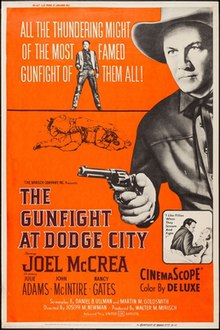The Gunfight at Dodge City
 From Wikipedia - Reading time: 5 min
From Wikipedia - Reading time: 5 min
| The Gunfight at Dodge City | |
|---|---|
 | |
| Directed by | Joseph M. Newman |
| Screenplay by | Martin Goldsmith Daniel B. Ullman |
| Story by | Daniel B. Ullman |
| Produced by | Walter Mirisch |
| Starring | Joel McCrea Julie Adams John McIntire |
| Cinematography | Carl E. Guthrie |
| Edited by | Victor Heerman |
| Music by | Hans Salter |
Production company | |
| Distributed by | United Artists |
Release date |
|
Running time | 81 minutes |
| Country | United States |
| Language | English |
The Gunfight at Dodge City is a 1959 American DeLuxe Color Western CinemaScope film. It was produced by the Mirisch Company, directed by Joseph M. Newman, co-written by Martin Goldsmith and Daniel B. Ullman and starred Joel McCrea as Bat Masterson.[1]
Plot summary
[edit]Bat Masterson sells his saloon to his friend Ben Townsend in order to make money hunting buffalo with Ben's young, disabled brother Billy. A psychotic gunman named Dave Rudabaugh warns Bat that he shouldn't sell his pelts in Hays City. Bat ignores him to come to town where he outdraws a cavalry sergeant making him travel to Dodge City where his brother Ed is the City Marshal.
The upright Ed complains that the County Sheriff Jim Regan is corrupt and destroys his efforts to clean up the town. Ed is in love with Pauline Howard, the daughter of a church minister, but has delayed his marriage for unknown reasons. In the meantime, Bat enters a partnership with Lily, the proprietress of the Lady Gay saloon who faces ruin as the Sheriff and his deputies are attempting to force them out of business by first murdering her original partner, then frightening off her croupiers. Bat battles the Sheriff and his deputies, but after they murder his brother he becomes the City Marshal and has to choose between Pauline and Lily.
Cast
[edit]- Joel McCrea as Bat Masterson
- Julie Adams as Pauline Howard
- John McIntire as Doc Sam Tremaine
- Nancy Gates as Lily, Lady Gay Saloon Owner
- Richard Anderson as Dave Rudabaugh
- James Westerfield as Reverend Howard
- Walter Coy as Ben Townsend
- Don Haggerty as Sheriff Jim Regan of Dodge City
- Wright King as Billy Townsend
- Harry Lauter as City Marshal Ed Masterson
Production
[edit]Following the success of the Mirisch Productions Joel McCrea Western Wichita (1955), Walter Mirisch decided to make another Western with McCrea. Originally entitled The Bat Masterson Story, Mirisch retitled the film The Gunfight at Dodge City to emulate the success of Gunfight at the O.K. Corral (1957).[2]
References
[edit]External links
[edit]- The Gunfight at Dodge City at IMDb
- The Gunfight at Dodge City at the TCM Movie Database
- The Gunfight at Dodge City at the AFI Catalog of Feature Films
 KSF
KSF